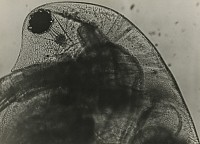BIOGRAPHY

1902–1989
Jean Painlevé was a French filmmaker and photographer whose work was innovative, both in its scientific exploration and its artistic expression. His underwater imagery of sea creatures helped expand the visual vocabulary of the Surrealists and his films were formative in avant-garde cinema. Though Painlevé's anti-authoritarian nature kept him from joining André Breton and becoming a Surrealist, his work was included in many of their publications and exhibitions. He took part in several Resistance networks during WWII and formed and held positions in numerous organizations to benefit French Cinema throughout his career.
His mother, Julie Marie Marguerite Petit de Villeneuve, died six weeks after Jean’s birth and thus Jean was raised by his father, Paul Painlevé, and his father’s widowed sister. Paul Painlevé was a distinguished mathematician and statesman who served twice as Prime Minister of France. Jean summered as a child with his maternal grandmother on the Southern coast of Brittany with his cousin Pierre Naville (the future editor and writer of the journal La Revolution Surréaliste). It was during these holidays that Jean developed a lifelong fascination with the sea and started photographing.
While initially studying medicine at Sorbonne University, he befriended Jacques-André Boiffard. Boiffard went on to join the Surrealists while Painlevé went on to study zoology and comparative anatomy. In the 1920s, Painlevé fell in love with Geneviève Hamon, who also became his closest collaborator and whose family home was the site of gatherings of many of the avant-garde of Paris. Their circle included avant-garde artists and writers such as Boiffard, Alexander and Louisa Calder, Robert Desnos, Max Jacob, Renée Jacobi, the Fernand Léger, Éli Lotar, Man Ray, Prévert brothers, André Raymond, Chaïm Soutine, and others.
The exhibition Jean Painlevé: Le pieds dans l'eau is at the Jeu de Paume from June 8–September 18, 2022.
Further thoughts:
Please read more about Jean Painlevé and explore his work further on the exceptional website of Archives Jean Painlevé where they also have excerpts of his films. In addition, I found the 2019 book by James Leo Cahill, Zoological Surrealism: The Nonhuman Cinema of Jean Painlevé an excellent source as well as the 2000 book, Science is Fiction: The Films of Jean Painlevé.
The first film by Painlevé that I saw was Le grand cirque Calder 1927 from 1955. I don’t remember when or where I saw it and I definitely didn’t know it was by Painlevé till much later. I do know it must have been early in my life, maybe at the Whitney, since Calder’s Circus was always my favorite attraction when I was a child and this film fueled my imagination and the possibilites of this seminal work.
Many of Painlevé’s early films are silent. I highly recommend listening to Yo La Tengo’s The Sounds of the Sounds of Science while viewing them as well as the images on our site. This is not my idea but rather one already achieved by The Criterion Collection’s DVD collection, Science is Fiction: 23 Films by Jean Painlevé.
—Tom Gitterman
